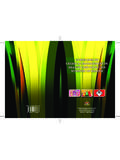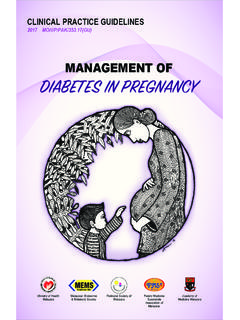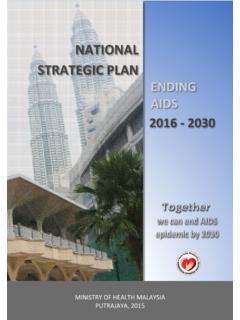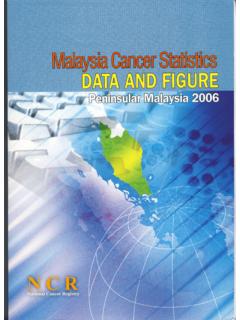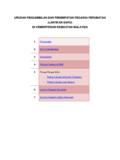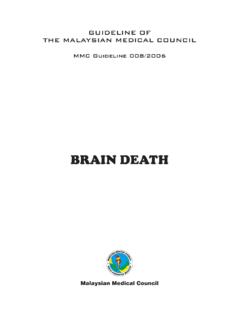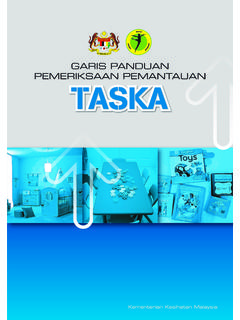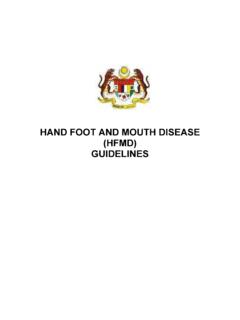Transcription of CPG Management of Dengue Infection In Adults …
1 1 CPG Management of Dengue Infection In Adults ( third edition )20152 CPG Management of Dengue Infection In Adults ( third edition )20153 Published by:Malaysia Health Technology Assessment Section (MaHTAS) Medical Development Division, Ministry of Health Malaysia Level 4, Block E1, Precinct 1 Federal Government Administrative Centre 62590, Putrajaya, MalaysiaCopyrightThe copyright owner of this publication is MaHTAS. Content may be reproduced in any number of copies and in any format or medium provided that a copyright acknowledgement to MaHTAS is included and the content is not changed, not sold, nor used to promote or endorse any product or service, and not used in an inappropriate or misleading : 978-967-0769-29-5 Available on the following websites: available as an app for Android and IOS platform:MyMaHTASSTATEMENT OF INTENTT hese clinical practice guidelines (CPG) are meant to be guides for clinical practice, based on the best available evidence at the time of development.
2 Adherence to these guidelines may not necessarily guarantee the best outcome in every case. Every healthcare provider is responsible for the Management of his/her unique patient based on the clinical picture presented by the patient and the Management options available locally. These guidelines were issued in 2015 and subject to be reviewed in minimum four (4) years time or in the advent of any significant change in Management of patient. When it is due for updating, the Chairman of the CPG or National Advisor of the related specialty will be informed about it. A discussion will be done on the need for a revision including the scope of the revised CPG. A multidisciplinary team will be formed and the latest systematic review methodology used by MaHTAS will be Management of Dengue Infection In Adults ( third edition )2015 TABLE OF CONTENTSEPIDEMIOLOGY1.
3 Dengue VIRUS AND SEROTYPE TRENDS IN MALAYSIA2. CLINICAL MANIFESTATIONS AND PATHOPHYSIOLOGY3. Spectrum of Dengue Clinical Course of Dengue Pathophysiology of Plasma Leakage in Severe Dengue WHO Dengue Diagnostic ChallengesDISEASE NOTIFICATION4. INVESTIGATIONS5. Disease Monitoring Diagnostic TestsINVESTIGATION OF POST MORTEM CASE6. Management OF Dengue INFECTION7. Outpatient Patient Triaging at Emergency and Outpatient Criteria for Hospital Referral / Disease Fluid ManagementALGORITHM A : Fluid Management in Compensated ShockALGORITHM B : Fluid Management in Decompensated ShockALGORITHM C : Fluid Management in Decompensated Shock (With Presence of Bleeding & Leaking/ Other Causes of Shock) Management of Complications in Dengue Intensive Care Management of Dengue InfectionDENGUE Infection IN PREGNANCY8.
4 DISCHARGE CRITERIA9. 1233357889991213131616182126272830374042 Levels of Evidence & Formulation of RecommendationGuidelines Development and ObjectivesGuidelines Development GroupReview CommitteeExternal ReviewersiiivviviiNo. Title Page4 CPG Management of Dengue Infection In Adults ( third edition )20155434343444656575860616263646 56667686868No. Title PagePREVENTION OF Dengue TRANSMISSION IN HOSPITALS10. VACCINATION11. FOOD AND SUPPLEMENTS12. IMPLEMENTING THE GUIDELINES13. REFERENCES14. Appendix 1 Search StrategyAppendix 2 Clinical QuestionsAppendix 3 World Health Organization (WHO) Classification of DF and DHF (1997)Appendix 4 Methods of Sample CollectionAppendix 5 Type of Tests for Dengue Diagnosis and Recommended UseAppendix 6 Type of Dengue Tests Recommended Based On Clinical HistoryAppendix 7 Outpatient Dengue Monitoring RecordAppendix 8 Dengue Assessment ChecklistAppendix 9 Home Care Advice Leaflet for Dengue PatientsAppendix 10 Inpatient Dengue Monitoring ChartList of AbbreviationsAcknowledgementDisclosure StatementSource of Funding45 CPG Management of Dengue Infection In Adults ( third edition )
5 2015 LevelStudy designIEvidence obtained from at least one properly randomised controlled trialII-1 Evidence obtained from well-designed controlled trials without randomisationII-2 Evidence obtained from well-designed cohort or case-control analytic studies, preferably from more than one centre or research groupII-3 Evidence obtained from multiple time series with or without the intervention. Dramatic results in uncontrolled experiments could also be regarded as this type of evidenceIIIO pinions of respected authorities based on clinical experience; descriptive studies and case reports; or reports of expert committeesSOURCE: US / CANADIAN PREVENTIVE SERVICES TASK FORCE 2001In line with the current development in CPG methodology, the CPG Unit of MaHTAS is in the process of incorporating Grading Recommendations, Assessment, Development and Evaluation (GRADE) in its work process.
6 The quality of each retrieved evidence and its effect size are carefully assessed/reviewed by the CPG Development Group. In formulating the recommendations, overall balances of the following aspects are considered in determining the strength of the recommendations:-Overall quality of evidence Balance of benefits vs harms Values and preferences Resource implications Equity, feasibility and acceptability LEVELS OF EVIDENCEi6 CPG Management of Dengue Infection In Adults ( third edition )20157 GUIDELINES DEVELOPMENTThe members of the Development Group (DG) for these Clinical Practice Guidelines (CPG) were from the Ministry of Health (MoH). There was also active involvement of a multidisciplinary Review Committee (RC) during the process of the CPG literature search was carried out using the following electronic databases: Guidelines International Network (G-I-N); Medline via Ovid, Pubmed and Cochrane Database of Systemic Reviews (CDSR) (refer to Appendix 1 for Search Strategy).
7 The inclusion criteria are all literature on Dengue Infection regardless of study design. The search was limited to literature published in the last five years, on humans and in English. In addition, the reference lists of all retrieved literature and guidelines were searched to further identify relevant studies. Experts in the field were also contacted to identify relevant studies. In certain situations, pivotal papers beyond the scope of search were used in the CPG. All searches were conducted from 26 May 2015 to 24 July 2015. Future CPG updates will consider evidence published after this cut-off date. The details of the search strategy can be obtained upon request from the CPG previous edition of CPG (2010) was used as the basis in updating these present guidelines. Reference was also made to other guidelines on Dengue Infection in Adults as well as handbooks from WHO such as Dengue Guidelines for Diagnosis, Treatment, Prevention and Control (2009) and Handbook for Clinical Management of Dengue (2012).
8 A total of 18 clinical questions were developed under different sections. Members of the DG were assigned individual questions within these sections. (Refer to Appendix 2 for Clinical Questions) The DG members met 7 times throughout the development of these guidelines. The literature retrieved was appraised by at least two DG members using Critical Appraisal Skill Programme checklist, presented in evidence tables and further discussed in each DG meetings. All statements and recommendations formulated after that were agreed upon by both the DG and RC. Where evidence was insufficient, the recommendations were made by consensus of the DG and RC. Any differences in opinion were resolved consensually. The CPG was based largely on the findings of systematic reviews, meta-analyses and clinical trials, with local practices taken into DEVELOPMENT AND OBJECTIVESii67 CPG Management of Dengue Infection In Adults ( third edition )2015 The literature used in these guidelines was graded using the US/Canadian Preventive Services Task Force Level of Evidence (2001) while the grading of recommendation was done using the principles of GRADE (refer to the preceding page).
9 On completion, the draft of the CPG was reviewed by external reviewers. It was also posted on the MoH Malaysia official website for feedback from any interested parties. The draft was finally presented to the Technical Advisory Committee for CPG, and the HTA and CPG Council MoH Malaysia for review and approval. Details on the CPG development by MaHTAS can be obtained from Manual on Development and Implementation of Evidence-based Clinical Practice Guidelines published in 2015 (available at ). iii8 CPG Management of Dengue Infection In Adults ( third edition )20159 OBJECTIVESGENERAL OBJECTIVESTo provide evidence-based guidance in the Management of Dengue Infection in adult OBJECTIVESTo improve recognition and diagnosis of Dengue cases and provide appropriate care to the improve on early and accurate notification of Dengue cases for prompt public health identify severe Dengue and carry out more focused close monitoring and prompt appropriate provide guidance on appropriate and timely fluid Management and the use of blood and blood create awareness on early detection of Dengue Infection with QUESTIONSR efer to Appendix 2 TARGET POPULATIONA dult patients with Dengue fever and severe GROUP/USERThis CPG is intended to guide those involved in the Management of Dengue Infection in Adults particularly healthcare professionals in primary and secondary/tertiary care namely.
10 -Physicians and specialists from related disciplinesa. Family Health Specialistsb. Medical officers and general practitionersc. Allied health professionals d. Pharmacistse. Students (medical postgraduates and undergraduates, and allied f. health students)Patients and carersg. HEALTHCARE SETTINGSO utpatient, inpatient and community settings inclusive of private healthcare Management of Dengue Infection In Adults ( third edition )2015Dr. Ahmad Tajuddin Mohamad NorConsultant Emergency Medicine SpecialistHospital Tengku Ampuan RahimahDr. Rose Nani MudinHead of Vector - Borne DiseasesDisease Control Division, MoHDr. Anilawati Mat JelaniInfectious Disease PhysicianHospital Raja Perempuan Zainab IIDr. Saiful Safuan Md. SaniInternal Medicine PhysicianHospital Kuala LumpurDr. Chow Ting SooConsultant Infectious Disease PhysicianHospital Pulau PinangDatin Dr. Salbiah Hj. NawiConsultant PathologistHospital Kuala LumpurDr.
